References:
Auto-Encoding Variational Bayes (Kingma and Welling 2013) https://
Variational Inference monograph from Michael Jordan https://
Stanford Notes (Stefano Ermon): https://
There are much more modern VAE variants used for NN-based compression nowadays. In particular, vector-quantized (VQ-VAE) is widely used because it discretizes the latent space and can learn high-frequency features. For open-source implementations, check out https://
This notebook aims to provide a basic introduction to the concept, with a minimal but effective implementation
Variational Inference¶
We start from the observation that maximum likelihood estimation (MLE) is equivalent to minimizing the Kullback-Leibler (KL) Divergence (also known as relative entropy) between the true distribution and the likelihood
Bayesian perspective: latent variable model
We could write
But this is computationally intractable because it’s impossible to know all possible latent variables .
Instead, we consider pairs of jointly, by sampling .
But how can we get ?
We must make it a learned function, and further approximate with
This is known as “Amortized Inference” and specifically, this is our encoder. As we will see later, the simplest way to make this tractable is to make an assumption of normality (that it’s Gaussian). There is a vast body of literature on this sort of thing, and we’ve swept a lot under the rug.
ELBO¶
Where the last inequality is by Jensen’s inequality, and ELBO stands for “Evidence Lower Bound.” This is the heart of many Variational Bayesian Inference applications.
Alternatively, from the perspective of variationally optimizing the amortized inference distribution, we can derive ELBO as follows:
And this also sheds light on the question: how tight is ELBO? - it depends on the amortized inference.
We can also write ELBO in another useful form, often used in practice:
So we end up with a cross entropy term (reconstruction loss) and a KL Divergence term
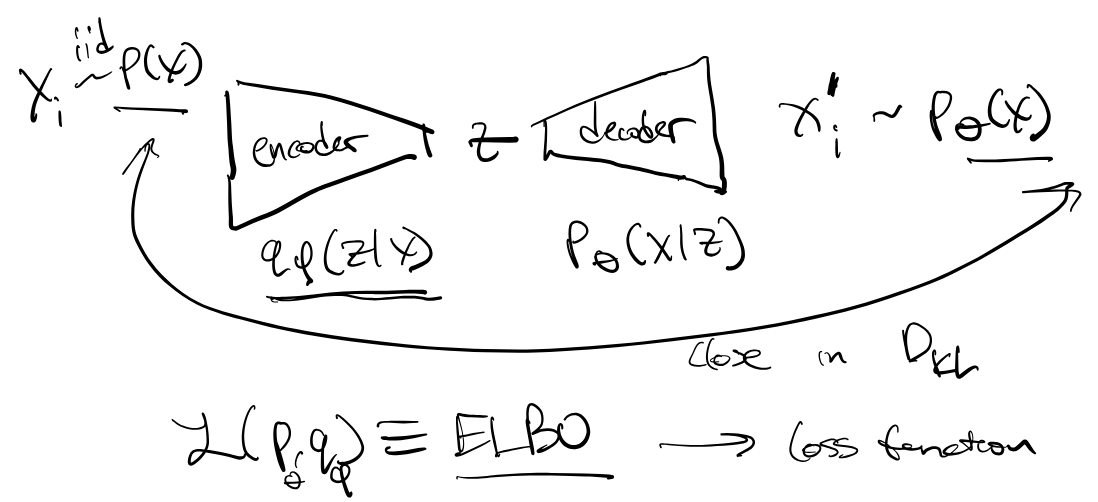
So now, our MLE program goes from:
(intractable)
To
(maximize ELBO)
We do gradient descent to compute the gradient updates:
For each or minibatch:
Compute:
Sample
Compute
Where is the learning rate
Reparameterization Trick¶
BUT the problem is that we cannot compute !!!
To see, this, we write:
The second term in the above expression goes away because the entropy is just some constant. The troublesome part is the first term. We cannot backpropagate through a stochastic node!
So, a straightforward solution to this problem is to use the “Reparameterization Trick” which is essentially a normality (Gaussianity) assumption on the amorized inference distribution (the encoder)

Implementation¶
Imports and Settings¶
import torch
from torch import nn
import torch.nn.functional as F
from torch.utils.data import DataLoader
import torchvision
from torchvision import datasets, transforms
from torchvision.datasets import MNIST
from matplotlib import pyplot as plt
import numpy as np
from sklearn.manifold import TSNE
import time# Set random seeds. We do this so that we can, in principle, reproduce results by "controlling" the pseudorandomness generation
# But warning: in some cases, Python pseudorandom number generator (PRNG) can be unreliable w.r.t its reproducibility
# i.e. when parallelizing a system, centralized state-based models for PRNG (as done below) start to yield inconsistent results
torch.manual_seed(1)
torch.cuda.manual_seed(1)# Set the device. Default to CPU
device = torch.device("cuda:0" if torch.cuda.is_available() else "cpu")Plotting Utils¶
# Display MNIST images
def display_images(x, n_rows=4, n_cols=4, img_size=1, title=None):
# plot generated data (outputed MNIST images)
x = x.data.cpu().view(-1, 28, 28)
plt.figure(figsize=(img_size * n_cols, img_size * n_rows))
plt.suptitle(title, color='k', fontsize=16, y=1.06)
for row_i in range(n_rows):
for i in range(n_cols):
image_i = (row_i * n_cols) + i + 1
ax = plt.subplot(n_rows, n_cols, image_i)
plt.imshow(x[image_i - 1], cmap='gray_r') # zero-indexed
ax.set_aspect('equal')
plt.axis('off')
plt.subplots_adjust(wspace=0, hspace=0)
# plt.show()Load Data¶
# Note that pixel balues of MNIST images are normalized to range [0, 1]
# download and transform train dataset
train_loader = torch.utils.data.DataLoader(datasets.MNIST('../mnist_data',
download=True,
train=True,
transform=transforms.Compose([
transforms.ToTensor(), # first, convert image to PyTorch tensor
])),
batch_size=256,
drop_last=True,
shuffle=True)
# download and transform test dataset
test_loader = torch.utils.data.DataLoader(datasets.MNIST('../mnist_data',
download=True,
train=False,
transform=transforms.Compose([
transforms.ToTensor(), # first, convert image to PyTorch tensor
])),
batch_size=256,
drop_last=True,
shuffle=True)train_images, train_labels = next(iter(train_loader))
sample_image, sample_label = train_images[0], train_labels[0]
print(sample_image.size())
print(sample_image.shape[1]*sample_image.shape[2])torch.Size([1, 28, 28])
784
Variational Autoencoder¶
Notes:¶
Define the encoder and decoder in the VAE module.
i) Build an encoder with Linear and RELU layers. For the last linear layer of encoder, define the output to be of size 2d, of which the first d values are the means and the remaining d values are the variances.
ii)We sample z∈ using these means and variances as per the reparameterisation trick z=E(z)+ϵ⊙√V(z) where ϵ∼N(0,)
iii)For decoder, mirror the architecture. For the last linear layer in the decoder, use the sigmoid activation so that we can have output in range [0, 1], similar to the input data.
For the reparameterise function, compute the standard deviation (std) from log variance (logvar). Use log variance instead of variance because we want to make sure the variance is non-negative, and taking the log of it ensures that we have the full range of the variance, which makes the training more stable.
For the forward function, compute the mu (first half) and logvar (second half) from the encoder, then compute the z via the reparameterise function. Finally, return the output of the decoder.
# Defining the model
d = 20
input_dim = 784 # 28*28 ... or, number of pixels in each MNIST image
# h_dims = [512, 256]
class VAE(nn.Module):
def __init__(self, input_dim, h1_dim, h2_dim, z_dim):
super(VAE, self).__init__()
self.input_dim = input_dim
# encoder layers
self.fc1 = nn.Linear(input_dim, h1_dim)
self.fc2 = nn.Linear(h1_dim, h2_dim)
# layer for mean
self.fc3_mu = nn.Linear(h2_dim, z_dim)
# layer for log variance
self.fc3_logvar = nn.Linear(h2_dim, z_dim)
# decoder layers
self.fc4 = nn.Linear(z_dim, h2_dim)
self.fc5 = nn.Linear(h2_dim, h1_dim)
self.fc6 = nn.Linear(h1_dim, input_dim)
def encoder(self, x):
h = F.relu(self.fc1(x))
h = F.relu(self.fc2(h))
# essentially splits latent code into two parts:
# first part for mean...
mu = self.fc3_mu(h)
# second part for log variance
logvar = self.fc3_logvar(h)
return mu, logvar
def decoder(self, z):
h = F.relu(self.fc4(z))
h = F.relu(self.fc5(h))
# sigmoid activation for reconstruction xhat ensures probability [0,1]
return F.sigmoid(self.fc6(h))
def reparameterise(self, mu, logvar):
'''
Reparameterization trick: use samples from N(0, 1) to sample from N(mu, var)
'''
std = torch.exp(0.5 * logvar)
eps = torch.randn_like(std)
return eps * std + mu
def forward(self, x):
# encode input image
mu, logvar = self.encoder(x.view(-1, self.input_dim))
# reparameterization trick
z = self.reparameterise(mu, logvar)
# decode latent code into output (generated) image
xhat = self.decoder(z)
return xhat, mu, logvar# Construct VAE model
model = VAE(input_dim=input_dim, h1_dim=512, h2_dim=256, z_dim=d).to(device)from torchsummary import summary
summary(model, (28,28))----------------------------------------------------------------
Layer (type) Output Shape Param #
================================================================
Linear-1 [-1, 512] 401,920
Linear-2 [-1, 256] 131,328
Linear-3 [-1, 20] 5,140
Linear-4 [-1, 20] 5,140
Linear-5 [-1, 256] 5,376
Linear-6 [-1, 512] 131,584
Linear-7 [-1, 784] 402,192
================================================================
Total params: 1,082,680
Trainable params: 1,082,680
Non-trainable params: 0
----------------------------------------------------------------
Input size (MB): 0.00
Forward/backward pass size (MB): 0.02
Params size (MB): 4.13
Estimated Total Size (MB): 4.15
----------------------------------------------------------------
# # for more detailed peek into model parameters
# for name, param in model.named_parameters():
# if param.requires_grad:
# print(name, param.data)
# print(model.parameters())
def count_parameters(model):
return sum(p.numel() for p in model.parameters() if p.requires_grad)
print(count_parameters(model))1082680
# set learning rate
learning_rate = 1e-3
# build Adam optimizer
optimizer = torch.optim.Adam(
model.parameters(),
lr=learning_rate,
)# Note: there are many Adam optimizer parameters to play with
optimizer.state_dict(){'state': {},
'param_groups': [{'lr': 0.001,
'betas': (0.9, 0.999),
'eps': 1e-08,
'weight_decay': 0,
'amsgrad': False,
'maximize': False,
'foreach': None,
'capturable': False,
'differentiable': False,
'fused': None,
'params': [0, 1, 2, 3, 4, 5, 6, 7, 8, 9, 10, 11, 12, 13]}]}Reconstruction Loss
Cross Entropy:
We will use the torch functional form of BCELoss, defined here: https://
# Reconstruction + beta * KL divergence losses summed over all elements and batch
def loss_function(x_hat, x, mu, logvar, beta=1):
'''
beta is hyperparameter we can use to weigh D_KL loss term
'''
# binary cross-entropy
bce_loss = F.binary_cross_entropy(x_hat, x.view(-1, input_dim), reduction='sum')
# KL divergence loss
kld_loss = -0.5 * torch.sum(1 + logvar - logvar.exp() - mu**2)
return bce_loss + beta * kld_lossTrain¶
Now, we train our VAE model using MNIST
%%time
# Train and Test loops
# TODO: plot train and test losses
epochs = 30
# # optional: set learning rate scheduler
# from torch.optim.lr_scheduler import CosineAnnealingWarmRestarts
# T_0 = 10
# scheduler = CosineAnnealingWarmRestarts(optimizer, T_0, T_mult=1)
# iters = len(train_loader)
# create dict (hashmap) to store learned means, log variances, and labels
codes = dict(mus=[], logvars=[], y=[])
train_losses = []
test_losses = []
for epoch in range(0, epochs + 1):
# Training
if epoch > 0: # test untrained net first
model.train()
train_loss = 0
for i, (x, _) in enumerate(train_loader):
x = x.to(device)
# ===================forward=====================
x_hat, mu, logvar = model(x)
loss = loss_function(x_hat, x, mu, logvar)
train_loss += loss.item()
# ===================backward====================
optimizer.zero_grad()
loss.backward()
optimizer.step()
# scheduler.step(epoch + i / iters)
avg_train_loss = train_loss / len(train_loader.dataset)
train_losses.append(avg_train_loss)
print(f'====> Epoch: {epoch} Average train loss: {avg_train_loss:.4f}')
# Testing
means, logvars, labels = [], [], []
with torch.no_grad():
model.eval()
test_loss = 0
for x, y in test_loader:
x = x.to(device)
# ===================forward=====================
x_hat, mu, logvar = model(x)
test_loss += loss_function(x_hat, x, mu, logvar).item()
means.append(mu.detach())
logvars.append(logvar.detach())
labels.append(y.detach())
codes['mus'].append(torch.cat(means))
codes['logvars'].append(torch.cat(logvars))
codes['y'].append(torch.cat(labels))
test_loss /= len(test_loader.dataset)
test_losses.append(test_loss)
print(f'====> Test loss: {test_loss:.4f}')
if epoch < 5 or epoch % 10 == 0:
display_images(x, n_rows=3, n_cols=10, title=f'Epoch: {epoch} - True Samples')
display_images(x_hat, n_rows=3, n_cols=10, title=f'Epoch: {epoch} - Generated Samples')====> Test loss: 542.6419
====> Epoch: 1 Average train loss: 198.6585
====> Test loss: 160.1502
====> Epoch: 2 Average train loss: 143.5970
====> Test loss: 131.5804
====> Epoch: 3 Average train loss: 126.4089
====> Test loss: 120.9595
====> Epoch: 4 Average train loss: 119.0689
====> Test loss: 115.5656
====> Epoch: 5 Average train loss: 114.8786
====> Test loss: 112.3046
====> Epoch: 6 Average train loss: 111.9135
====> Test loss: 110.0687
====> Epoch: 7 Average train loss: 109.8161
====> Test loss: 108.1675
====> Epoch: 8 Average train loss: 108.2326
====> Test loss: 106.9488
====> Epoch: 9 Average train loss: 107.0512
====> Test loss: 105.9104
====> Epoch: 10 Average train loss: 106.1159
====> Test loss: 105.3167
====> Epoch: 11 Average train loss: 105.3335
====> Test loss: 104.6914
====> Epoch: 12 Average train loss: 104.6853
====> Test loss: 104.0469
====> Epoch: 13 Average train loss: 104.0993
====> Test loss: 103.7665
====> Epoch: 14 Average train loss: 103.6275
====> Test loss: 103.3899
====> Epoch: 15 Average train loss: 103.1329
====> Test loss: 102.8664
====> Epoch: 16 Average train loss: 102.7484
====> Test loss: 102.7843
====> Epoch: 17 Average train loss: 102.3573
====> Test loss: 102.4456
====> Epoch: 18 Average train loss: 102.0150
====> Test loss: 102.1641
====> Epoch: 19 Average train loss: 101.6891
====> Test loss: 101.7669
====> Epoch: 20 Average train loss: 101.4260
====> Test loss: 101.7920
====> Epoch: 21 Average train loss: 101.1566
====> Test loss: 101.6301
====> Epoch: 22 Average train loss: 100.8425
====> Test loss: 101.5263
====> Epoch: 23 Average train loss: 100.7230
====> Test loss: 101.1720
====> Epoch: 24 Average train loss: 100.4349
====> Test loss: 101.0839
====> Epoch: 25 Average train loss: 100.2473
====> Test loss: 100.8849
====> Epoch: 26 Average train loss: 100.1000
====> Test loss: 100.8312
====> Epoch: 27 Average train loss: 99.8234
====> Test loss: 100.6125
====> Epoch: 28 Average train loss: 99.6859
====> Test loss: 100.5676
====> Epoch: 29 Average train loss: 99.5252
====> Test loss: 100.2978
====> Epoch: 30 Average train loss: 99.3682
====> Test loss: 100.4724
CPU times: user 4min 17s, sys: 1.48 s, total: 4min 18s
Wall time: 4min 26s
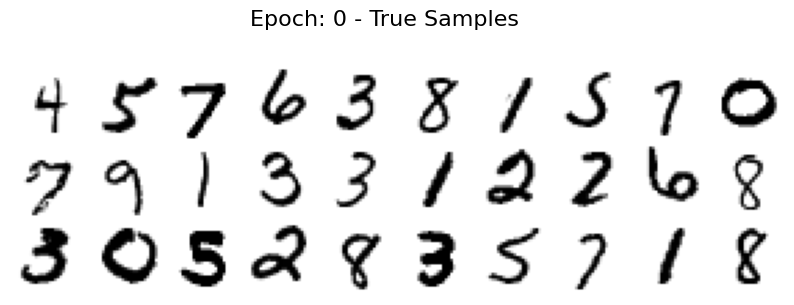
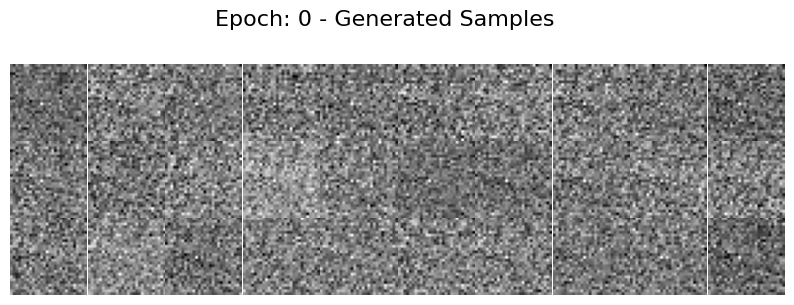
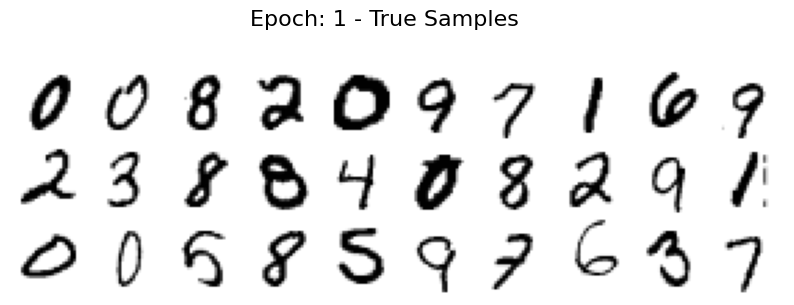
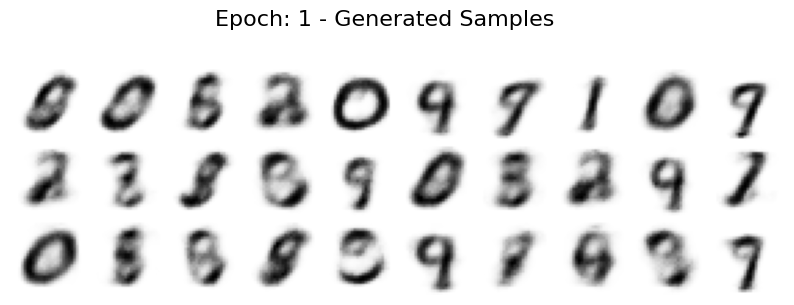

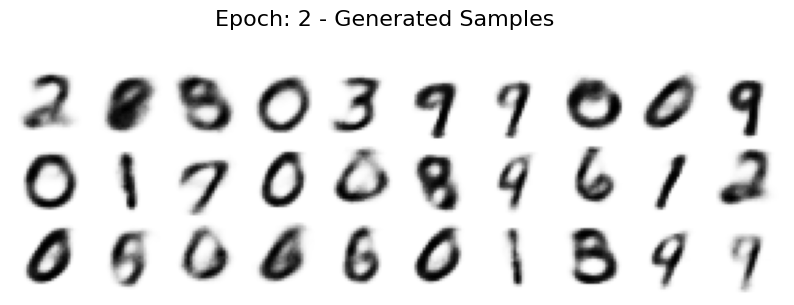
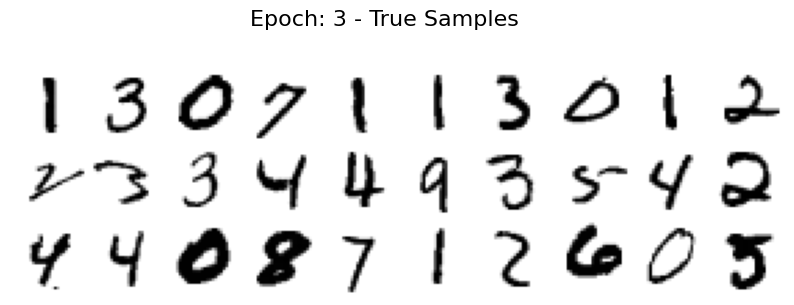
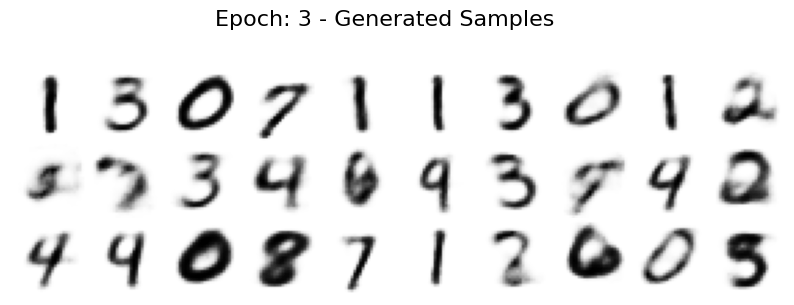
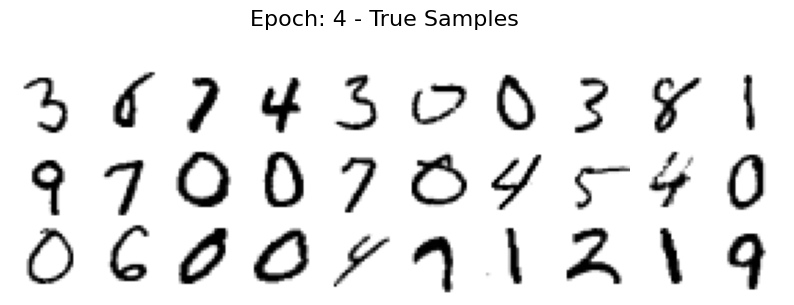

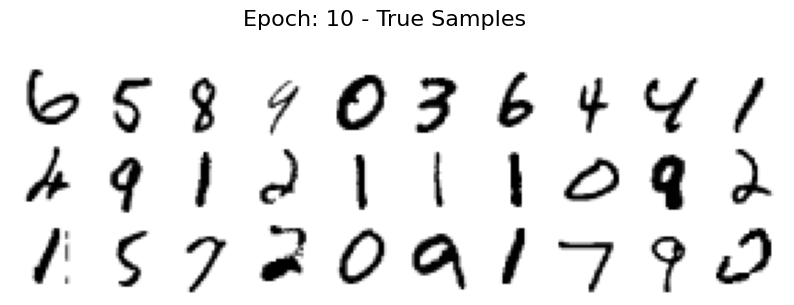
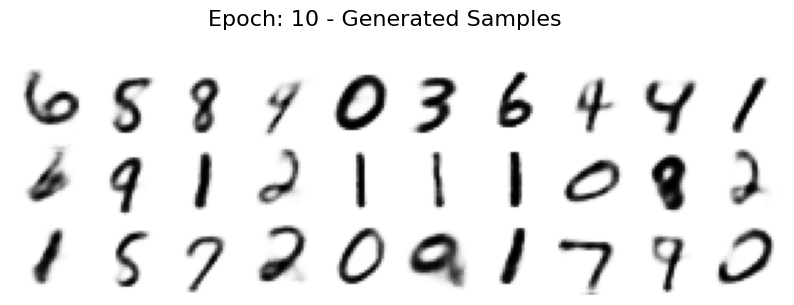
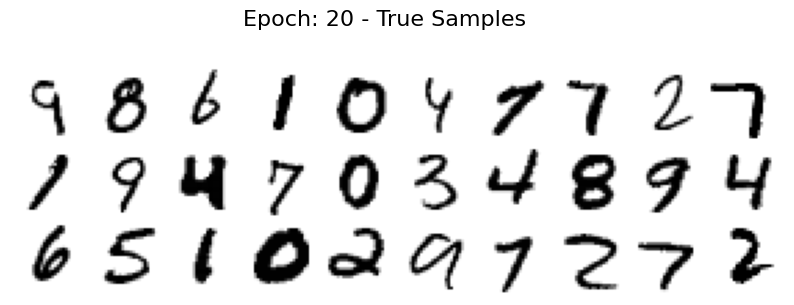
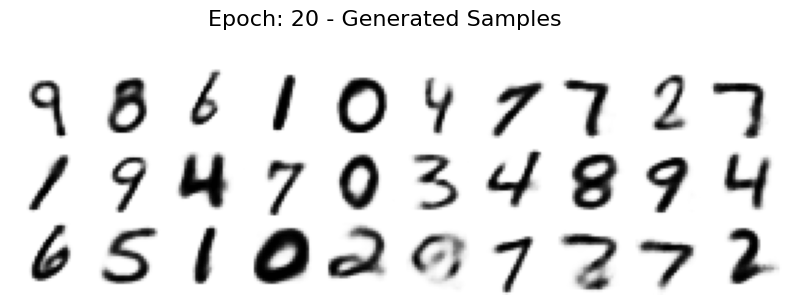
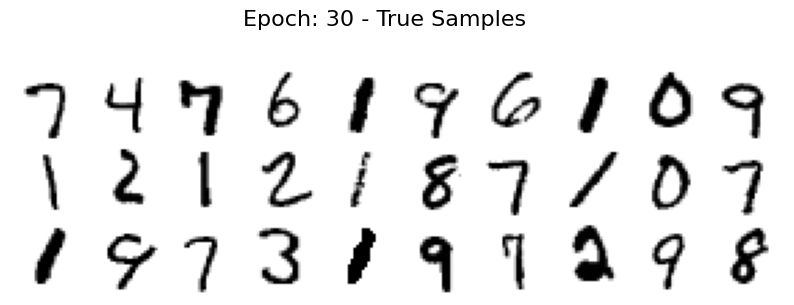

Visualize Loss Curves¶
plt.figure(figsize=(7, 5))
plt.title("Loss History")
plt.plot(train_losses, label="train loss")
plt.plot(test_losses, label="test loss")
plt.legend()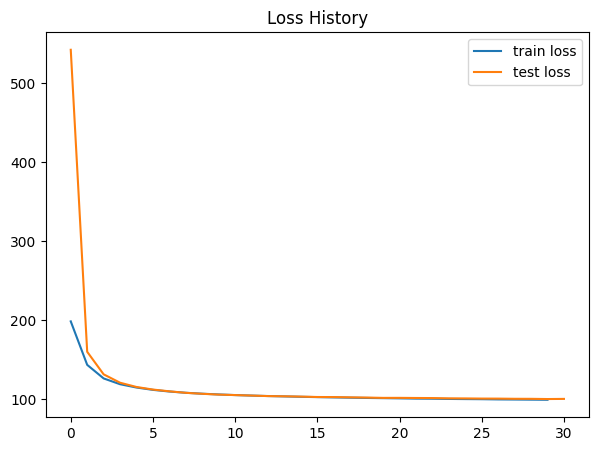
Visualize Generated Images¶
# Generating a few samples
N = 20
z = torch.randn((N, d)).to(device)
sample = model.decoder(z)
display_images(sample, n_rows=2, n_cols=10)
Visualize True Images¶
# Display last test batch
display_images(x, n_rows=2, n_cols=10)
Interpolation Experiments¶
# Choose starting and ending point for the interpolation -> shows original and reconstructed
A, B = 1, 3
true_sample = torch.concat((x[A], x[B]), 0)
gen_sample = model.decoder(torch.stack((mu[A].data, mu[B].data), 0)) #.reshape(-1,28,28)
print("true sample, interpolation endpoints")
display_images(true_sample, n_rows=1, n_cols=2)
plt.show()
print("generated sample, interpolation endpoints")
display_images(gen_sample, n_rows=1, n_cols=2)true sample, interpolation endpoints

generated sample, interpolation endpoints

# Perform an interpolation between input A and B, in N steps
N = 20
code = torch.Tensor(N, 20).to(device)
sample = torch.Tensor(N, 28, 28).to(device)
for i in range(N):
code[i] = i / (N - 1) * mu[B].data + (1 - i / (N - 1) ) * mu[A].data
# sample[i] = i / (N - 1) * x[B].data + (1 - i / (N - 1) ) * x[A].data
sample = model.decoder(code)
display_images(sample, n_rows=2, n_cols=10)
# def set_default(figsize=(20, 10), dpi=100):
# plt.style.use(['dark_background', 'bmh'])
# plt.rc('axes', facecolor='k')
# plt.rc('figure', facecolor='k')
# plt.rc('figure', figsize=figsize, dpi=dpi)X, Y, E = [], [], [] # input, classes, embeddings
N = 1000 # samples per epoch
epochs = (0, 5, 10, 30)
for epoch in epochs:
X.append(codes['mus'][epoch][:N])
E.append(TSNE(n_components=2).fit_transform(X[-1].detach().cpu()))
Y.append(codes['y'][epoch][:N])
Latent Space Visualization¶
f, a = plt.subplots(ncols=4, figsize=(18,4))
for i, e in enumerate(epochs):
s = a[i].scatter(E[i][:,0], E[i][:,1], c=Y[i], cmap='tab10')
a[i].grid(False)
a[i].set_title(f'Epoch {e}')
a[i].axis('equal')
f.colorbar(s, ax=a[:], ticks=np.arange(10), boundaries=np.arange(11) - .5)
As training progresses, it is very clear that the latent space develops clusters corresponding to each digit. And we can make some observations about the closeness of certain digits to each other. For example, it makes sense that 4 and 9 overlap.